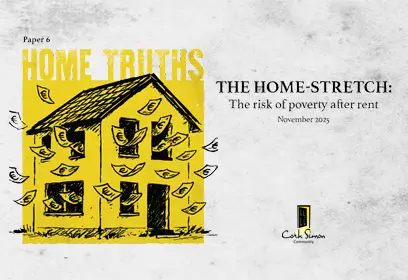
For far too many households here in Cork, the hope of finding a safe, affordable home is slipping away. In just a year, rents rose almost 12% in Cork City while available rental properties fell by 8%, leaving renters with dwindling options and mounting pressures.
The HAP Gap
For thousands of households, the Housing Assistance Payment (HAP) – designed to help those with a social housing need secure accommodation in the private rental sector, is no longer fit for purpose.
The last four consecutive Simon Communities of Ireland Locked Out of the Market reports found zero properties available to rent within HAP limits in the Cork areas surveyed. In other words, even with support, there are no homes within reach.
As we highlight in our latest Home Truths paper, The Home Stretch: the risk of poverty after rent, the gap between HAP limits and actual rents forces many households to make unsustainable “top-up” payments directly to landlords – on top of their official rent contribution. These unofficial payments are pushing tenants deeper into hardship.
Ireland’s Hidden Tenth
When supply is falling, rents are rising, competition is intensifying and HAP is increasingly becoming unfit for purpose for many households, the formal rental market shuts out low-income households. What’s left is the informal market – at high cost, high risk, and little security.
When CSO Census 2022 data was cross-checked against RTB (Residential Tenancies Board) registrations, it revealed about 50,000 informal rental arrangements – properties being rented out but not registered with the RTB. A further 25,000-plus potentially formal rentals appeared to also not be registered with the RTB, meaning their tenants likely lack full legal protections.
Out of roughly 500,000 households in rental accommodation nationally, about one in ten – the hidden tenth – exist outside regulation or protection. The invisible tenth – the unseen reality of Ireland’s rental crisis.
What the Hidden Tenth Looks Like
As Cork Simon staff member Gabriel puts it: “A lot of the times, the lads would end up having to go for properties that a lot of other people wouldn’t be going for. They’re in bad neighbourhoods, in very poor condition, where standards of living are extremely low—but the prices are still very high. They have to settle for less.”
While still paying high rent, our service users describe sub-standard, unregulated properties – the only ones they can access. Properties deemed uninhabitable by most standards.
Mould is frequent. Insulation is poor. Draughts whistle through windows and doors, driving up heating bills.
As Cork Simon service user, Barry put it: “We went through so much gas and electricity trying to heat the place. The bills were f****** extortion. There was, like, a big gap under the back door, windows weren’t amazing in certain parts of the house, a utility where the window was always open to feed out the thing for the dryer. Heating was literally leaving our house.”
Many tenants are reluctant to report issues. Some don’t want to draw attention, others know there’s no point as nothing will be done about it as they have no recourse.
For another service user, Bernard, fixing problems himself became part of his informal rental agreement: “We had, like a bed-sit for ourselves. And I was helping with the maintenance of the gaff, like. The housing was below the standard for the Rent Allowance; he couldn’t get a Rent Allowance on the gaff. I was painting it twice a year and the damp was coming out.”
No Lease, No Security
In this informal rental sector, sub-lets and cash-in-hand arrangements are common. No lease. No receipts. No security.
Barry described the abrupt end of his sub-let: “I just had to leave, kind of into nothingness.”
With no legal recourse, tenants in informal rentals live with constant uncertainty and are all the more susceptible to sudden eviction and homelessness.
The Human Cost
Beyond the physical quality of rental accommodation, the security and stability of where we live profoundly affects our health and wellbeing.
Gabriel sees this every day: “They’re grateful that they have even that accommodation because they know the alternative is the street, but it can affect people’s mental health.”
Living with damp walls, the threat of sudden eviction, and all the while paying high rent which leads to ongoing financial strain and impossible trade-offs – experiences consistently reported by service users in our latest Home Truths report, The Home Stretch, leaves people under constant stress and pressure.
What Needs to Happen
People need secure, stable and affordable housing. It’s a basic human necessity. This requires urgent action on multiple fronts:
- Reform HAP so its current limits reflect real market rents, giving households a real chance to access safe, habitable homes.
- Strengthen enforcement to bring the hidden tenth into the regulated system, ensuring all renters have legal protections.
- Increase social and affordable housing supply to reduce dependence on an increasingly dysfunctional private rental market.
- Support tenants to report sub-standard conditions without fear of losing their homes.
The hidden tenth cannot remain invisible. Ireland’s rental crisis demands solutions that acknowledge its full scale – including those households trapped in the informal market with nowhere else to turn.
